For my target audience, I have chosen to focus on attracting other photographers, amateur and pro, also people who are interested in photography to my photos. For my target audience research, I have chosen to do some research on the demographics of pro photographers.
These statistics were taken and gathered from 2,310 professional photographers who had a photographer has a full- time or a part-time job. out of 2,310 photographers, the average age of the male photographers was 50.5 years old compared to the females who were on average 41.0 years old. This is important information because with my information about photographer website and social media I can see what websites have a demographic most similar to the pro-photographer age.
The big difference between male and female pro-photographers is the annual revenues. The average revenues for male pro photographers are $154,500 compared to female photographers which is $48,100. This is a big difference but it is very understandable, 64% of male pro-photographers work full-time while only 51% of female for full-time. The average time as a pro-photographer for males is 18.9 while the average duration as a pro-photographer is 9.0 years. This information doesn’t really help me, but it could be an indication when certain female photographers might lose interest in their craft.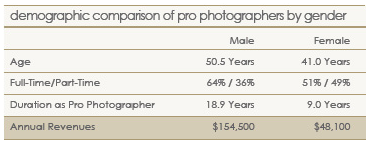
Looking at this graph that shows the most common and popular area of photography that the pro-photographers fall under, I can see that the most popular is portrait. This is very predictable because this is the most popular area of photography that people want to pay for, this is a very good way of making money and working as a photographer both full-time and part-time. The next popular photography area is Fine-art, fine art photography is a big area of photography, Basically fine art photography is a photo that is created and molded to portray the photographer vision and intentions of the photo. A couple of the areas that could come under fine art photography is Landscape, portrait and also architecture.
En.wikipedia.org. (2019). Fine-art photography. [online] Available at: https://en.wikipedia.org/wiki/Fine-art_photography [Accessed 7 Feb 2019].
According to this graph, the percentage of photographers that make money from architecture photography, full-time or part-time is 18%, this isn’t as popular as a portrait but this is understandable because there isn’t as much demand to get photographs of buildings. Looking at the urban part of my photography, I think that it would come under fine art because with my urban photography I am trying to convey and evoke emotion to the people who look at my photos. The least popular photography areas are travel, fashion, pets, and catalogue.
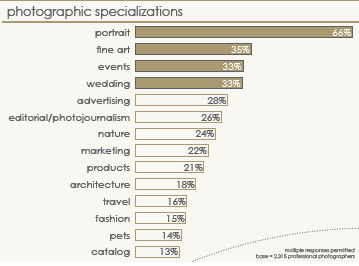
From this website, I have also gathered some information about the percentage of pro-photographers that use the internet for business. According to this graph in 2009 74% of pro-photographers were currently using the web for business, 13% were currently in the process of setting up on the internet and 13% of them were not using it and had no interest to do so. Looking at the same questions asked but in 2010, 81% of people said they were currently using the web, 10% were currently in the process of setting up and the 9% were not using. In 2011, 78% were currently using, 12% were in the process of setting up and 9% were not using. The final year recorded was 2012, in this year the percentage of people currently using the internet for business was 86%, the percentage of people who were in the process of setting up was 8% and 6% are not using and have not planned to do so. From this graph, you can see there is an increase each year of the percentage of people using the internet for business except 2011 when it went down to 78% from 81%. You can see that the internet has become more popular and more of a necessity for pro-photographers for business. The increase between 2009 and 2012 is 12% for people using the internet for business. The amount of people in the process of setting up their business on the internet has decreased by 5% from 2009 to 2012, this is probably because over the years they have realized how necessary the internet in for business, and that has made them focus more time and effort doing that. The percentage of people who are not using the internet for their photography business has decreased by 7%.
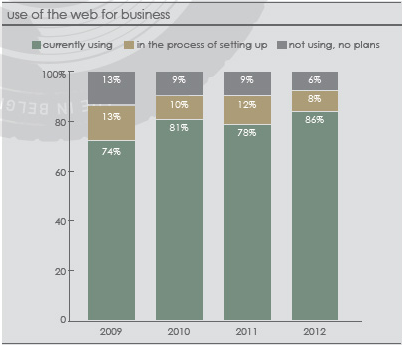
Ai-ap.com. (2019). AI-AP | Pro Photo Daily » The State of the Art: Demographics and Trends in Professional Photography. [online] Available at: https://www.ai-ap.com/publications/article/5952/the-state-of-the-art-demographics-and-trends-in.html [Accessed 7 Feb 2019].
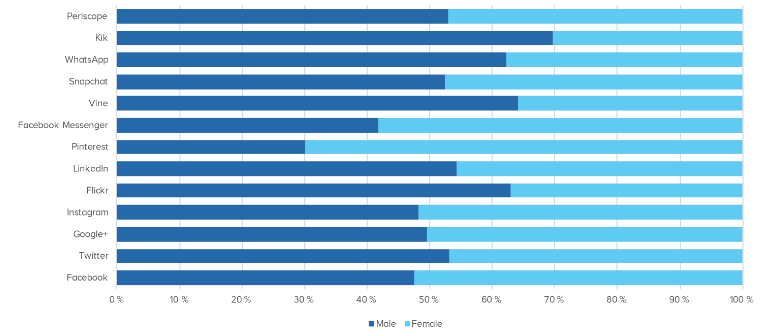
This graph above shows the percentage of males and females who use the service. The main two that I am looking at are Flickr and Instagram, These two are the most important to me because these two are very focused on photos and sharing your photos. This was a justified decision, because of the research I did on presentation. The percentage of males who use Flickr is about 63% and 37% for females, this is understandable because Flickr is more focused and aimed at pro-photographers and from my other research I know photography as an occupation is male-dominated. Looking at the Instagram section I can see that there are more females are using Instagram with about 52% and 48% for males. This is why I have chosen males and females as my demographic because there are more males on Flickr but there are more females on Instagram.
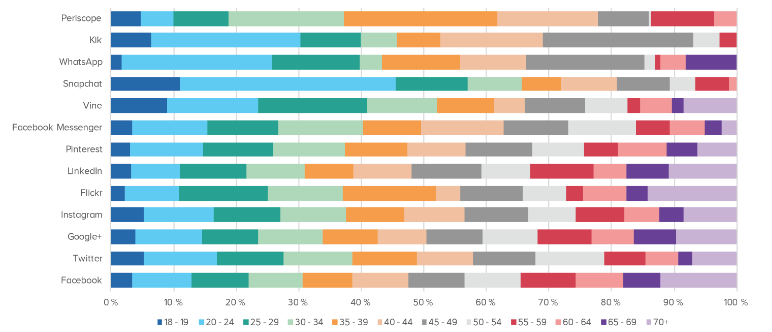 Analytics, V. (2019). The Demographics of Social Media. [online] Verto Analytics. Available at: https://www.vertoanalytics.com/the-demographics-of-social-media-properties-looking-beyond-downloads/ [Accessed 7 Feb 2019].
Analytics, V. (2019). The Demographics of Social Media. [online] Verto Analytics. Available at: https://www.vertoanalytics.com/the-demographics-of-social-media-properties-looking-beyond-downloads/ [Accessed 7 Feb 2019].
Looking at this graph I am only looking at Flickr and Instagram because from my research I have that these are the only two out of the 13 services that focus and have there main interest of the photo side of thing. Instagram is solely focused on photos and videos and that’s the same with Flickr, this is just mainly focused on more serious photographers.
Looking at the statistics for Flickr, you can see that it is very popular with people aged 35-39, this is because this website is focused on more professional photographers I the average age of a professional is usually this age range and higher. My target audience is 18-40 so this age range is included in mine. There is also a lot of people who use Flickr who are in the younger age ranges which are still included in mine so I think that Flickr is the best website to upload my images to.
The most popular age range for Instagram is 20-24, this is because Instagram is more based on communication through images and a place to upload your snapshots. Instagram is also a very good social network for amateur and pro photographers to gain exposure.
The main reason I have chosen to pick the age range 18-40 because of these two services. Instagram is more dominated by younger people while Flickr is more based at older more established photographers. So if I cover both popular age ranges I can target more people.
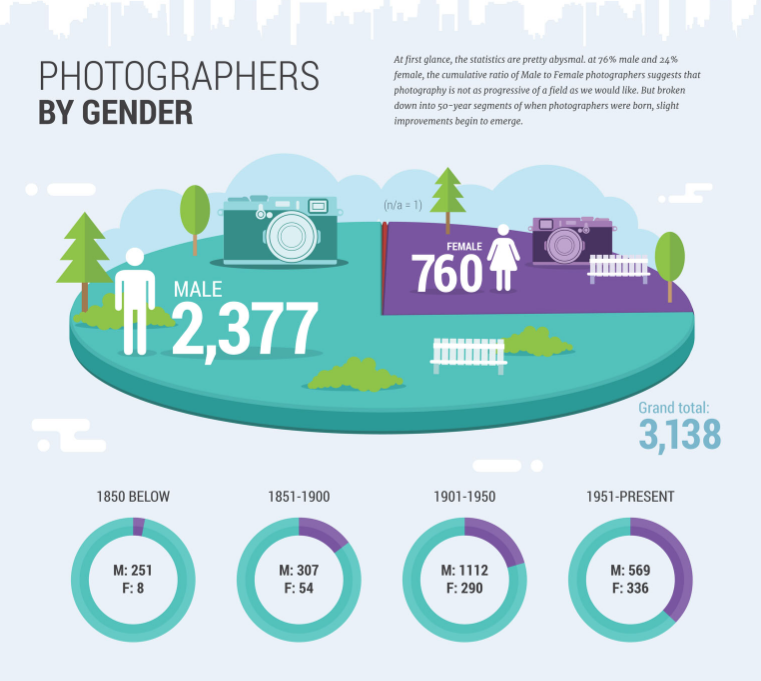 N., H. (2019). Infographics: What We Learned About Gender Diversity From Over 3,000 Photographers – ONWARD. [online] ONWARD. Available at: https://onwardphoto.org/gender-diversity-in-the-fine-art-photography-industry/ [Accessed 7 Feb 2019].
N., H. (2019). Infographics: What We Learned About Gender Diversity From Over 3,000 Photographers – ONWARD. [online] ONWARD. Available at: https://onwardphoto.org/gender-diversity-in-the-fine-art-photography-industry/ [Accessed 7 Feb 2019].
Looking at these pie charts we can see how many people were male and female out of a number of people, these pie charts and broken up into different time people where born. Looking at the chart that shows people born in 1850 and below, you can see that 251 of 259 where male photographers and that 8 of them were female. The reason I think that there wasn’t a lot of women photographers is that at the time photography wasn’t as popular and because in the 19th-century women were expected to take care of the house, cleaning, cooking and taking care of the children. This would limit and stop the women on maybe pursuing a career in photography.
The chart of photographers born in 1851-1900 is slightly different from the previous chart. 307 people out of 361 are males and 54 of the 361 are female, so there are still more males than females but the number of females has increased. I think that the reason there are more females photographers than females born in 1850 or below because photography has become more popular and more regarded as an occupation.
Looking at the chart for 1902-1950 you can that 1112 out of the 1402 people are male and 290 are females. This is the time when photography started to get really popular and becoming a full-time job for some people. I think that there are more females because there were more jobs for females to do. In this time period, two world wars happened, so this gave the females chances to work in any occupation, not just photography, this is because a lot of the men were at war. An example of jobs available for females at this time is photojournalism and documentary photography because of the wars.
The last chart shows the photographers that were born in 1951 to the present. 569 of the 905 people were men and 336 were female. This chart has a lot more female photographers, I think that this is because females are able to choose whatever they want to do as their occupation. Also, the traditional female’s roles were becoming less and less popular in nuclear families. This gave women more chance of pursuing their careers, whatever that might be.
Looking back on all of these charts I can see that there is a similarity, over time there has been a constant increase of female photographers, the latest shows that it is getting very close to 50/50. There will always be a more popular gender for anything for a different reason. This is the reason I chose to have both genders for my target audiences because they both take up a big proportion of the photographers in the world.
Social Demographic

Google.com. (2019). Redirect Notice. [online] Available at: https://www.google.com/url?sa=i&source=images&cd=&ved=2ahUKEwibuMfsq4niAhVG1eAKHaerCHQQjxx6BAgBEAI&url=http%3A%2F%2Fmdwestcott.blogspot.com%2F2015%2F09%2Fabc1-social-demographic-scale.html&psig=AOvVaw0b3xm-HXOYBoMdUYQCNzBN&ust=1556963689786316 [Accessed 7 Feb 2019].
This table shows the different kind of people that are in sociaty and grouped them up and placed them into grades, the reason for the table to me, is to see what grade that my target audiences is. The bottom grade, grade E is a person who doesnt have any skills in manual work and someone who doesnt have alot of money, like a pensioners of a widow who doesnt have any means of making money.
Grade D is a person who is working class and who has little to no skill is the manula work area. Looking a grade C2, this grade is the people who are skilled manual workers and also skilled working class. C1 is the peopler who are in the lower middle class who has a more of a proffesional job like a administrative or a junior mangerial. The B class is where we look at the people in the middle class and people who work as managerial, administrative or professional. Grade A is the highest grade, this grade looks at the upper middle class and the people who are higher managerial, administrative or professional.
The social demographic of my target audience is C2 – B, I decided this range because photography is a very popular hobby and occupation. Also, photography is a very hard field of work to get into, therefore I don’t think people in grade D or E would be photographers or be interested in photography.